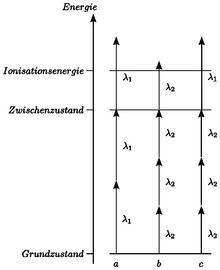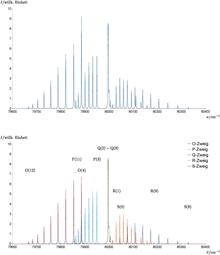Resonance-enhanced multiphoton ionization
The resonance-enhanced multiphoton ionization ( English resonance enhanced multiphoton ionization = REMPI) is an ionization technique in which molecules by laser pulses are ionized. The ions generated with this technology are usually detected by methods of mass spectrometry and thus used for chemical analysis .
principle
The ionization of a molecule by REMPI takes place in two steps, each of which involves one or more photons . The number of photons involved in the steps is indicated by the notation ( ) -REMPI. If all the photons involved have the same wavelength , one speaks of a single-color REMPI, with different photon energies of multi-color REMPI. The first step is the absorption of photons and the associated excitation of the molecule into a resonant intermediate state with a finite lifetime (often a Rydberg state ). The second step is the ionization of the molecule by further photons out of the resonant intermediate state. More energy can be absorbed than is necessary to reach the ionization energy. In this case, the excess energy is given off as kinetic energy with the electron leaving the molecule. The resulting ion can be detected by mass spectrometry, which means that substance-specific spectra can be recorded from mixtures .
The excited bound states achieved in the first step correspond to those that are also examined by means of UV / VIS spectroscopy . A REMPI experiment thus provides data both on the UV / VIS spectrum and on the mass spectrum of a substance and is therefore referred to as a 2-dimensional experiment.
Properties of the method
The REMPI is a soft ionization method due to the photon energy given by the wavelength of the laser used. H. Most of the molecular ions formed do not have enough excess energy to fragment into smaller fragments .
The probability of multiphoton ionization depends on the light intensity as follows :
stands for the non-linearity of the process, which can be equated with the number of photons required. Accordingly, multiphoton processes require high light intensities. This relationship can be illustrated by the fact that for an excitation with three photons these must arrive at the molecule at the same time. A REMPI process therefore requires less strong laser fields than the corresponding regular multiphoton ionization, since the required total number of photons is absorbed in two steps. A large number of ions can easily be generated by using intensive laser radiation.
Depending on the number of photons , the selection rules in the first step can differ from those in UV / VIS spectroscopy. With REMPI, for example, transitions between states with the same parity (3s → 4s) can be observed if it is even.
Selection rules

The band structure of a single electronic transition can be seen in the picture on the right using an example. A REMPI spectrum consists of signals of many electronic transitions, which can energetically overlap, so that the spectrum can become very complex. Signals belonging to the same electronic transition are classified into branches depending on the change in the total angular momentum quantum number . Transitions with the letters… O, P, Q, R, S… are assigned following the alphabet. A number in round brackets after the letter stands for the total angular momentum quantum number of the initial state, e.g. B. S (2).
The absence of bands in a REMPI spectrum can have various causes. Among other things, the R (0), Q (1) and Q (0) bands are missing in the example transition. The reason is easy to see when looking at the term symbols of the states involved. Due to its electronic structure , the state has a total angular momentum quantum number of . Thus, no transition is possible that would have a total angular momentum quantum number of less than 2 in the target state.
During the ionization step in (2 + 1) -REMPI, a photon is absorbed and an electron ( fermion , ) leaves the molecule. The selection rule for this step is thus . This explains why the generated ions only occupy a few rotational states.
Possible areas of application
The REMPI mass spectrometry helps in the investigation of complex mixtures of several thousand chemical compounds and is therefore mainly used in the research of biological systems , such as energy sources, e.g. B. fossil fuels or pyrolysis processes . The ionization technology can be used in many ways in connection with a very fast scanning mass analyzer . Suitable mass analyzers are above all different versions of time- of- flight mass spectrometers , which differ mainly in their geometrical structure. The selectivity for aromatic compounds makes the use in combustion processes such. B. possible in waste incineration plants for the detection of toxic PAHs or dioxins .
Trace components in flue gases from combustion processes are detected using a quartz probe, from which part of the gas is introduced into the ion source as a mixture through a particle filter and a heated, deactivated quartz capillary . The UV laser is attached almost orthogonally to the entry direction. The ion beam is transferred to a time-of-flight mass spectrometer via ion optics . The substance class selectivity of the first excitation process enables so-called "REMPI" profiling, in which polyaromatic compounds such as anthracene or benzopyrene can be easily ionized out of the mixture.
The method can also be used to characterize roasting gases in coffee production . The roasted products are recorded time-resolved and statistically evaluated. A statement about the degree of roasting is made using characteristic time-intensity profiles. Corresponding marker substances are primarily various derivatives of phenol as well as indole and furfural . The degree of roasting ranges from cinnamon to espresso.
The possibility of using REMPI to generate ions in certain quantum states is part of current research, with the aim of investigating the kinetics of ion-molecule reactions as a function of, for example, the ion's rotational energy. The findings could help to make plasma chemistry processes more efficient.
Individual evidence
- ↑ J. Bakos, A. Kiss, L. Szabó, M. Tendler, Physics Letters , 1972 , 43 , 163-164.
- ↑ M. Michel, MV Korolkov, K.-M. Weitzel, J. Phys. Chem. A , 2004 , 108 , 9924-9930.
- ^ HJ Heger, R. Zimmermann, R. Dorfner, M. Beckmann, H. Griebel, A. Kettrup , U. Boesl, Anal. Chem. , 1999 , 71 , 46-57.
- ↑ MJ Petròn, JA García-Regueiro, L. Martín, E. Muriel, T. Antequera, J. Agric. Food Chem. , 2003 , 51 , 5786-5791.
- ^ R. Dorfner, T. Ferge, C. Yeretzian, R. Zimmermann, Anal. Chem. , 2004 , 76 , 1386-1402.
- ↑ L. Paetow, F. Unger, B. Beutel, K.-M. Weitzel: J. Chem. Phys. , 2010 , 133 , 234301.
















